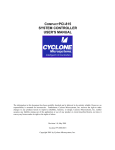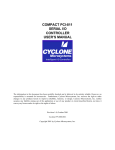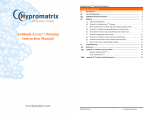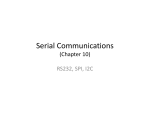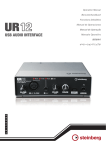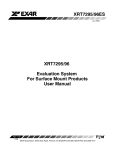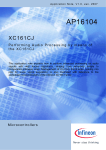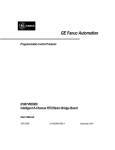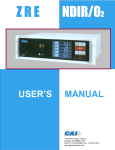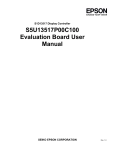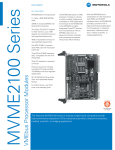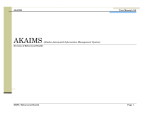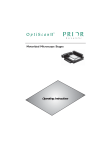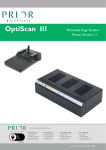Download COMPACTPCI-817 PERIPHERAL BOARD USER`S MANUAL
Transcript
COMPACTPCI-817 PERIPHERAL BOARD USER’S MANUAL The information in this document has been carefully checked and is believed to be entirely reliable. However, no responsibility is assumed for inaccuracies. Furthermore, Cyclone Microsystems, Inc. reserves the right to make changes to any products herein to improve reliability, function, or design. Cyclone Microsystems, Inc. neither assumes any liability arising out of the application or use of any product or circuit described herein, nor does it convey any license under its right or the rights of others. Revision 1.0, June 2001 Cyclone P/N 800-0817 Copyright 2001 by Cyclone Microsystems, Inc. CONTENTS CHAPTER 1 GENERAL INTRODUCTION 1.1 INTRODUCTION................................................................................................................................. 1-1 1.2 FEATURES ......................................................................................................................................... 1-2 1.3 OVERVIEW ......................................................................................................................................... 1-3 1.4 SPECIFICATIONS ...............................................................................................................................1-3 1.5 ENVIRONMENTAL.............................................................................................................................. 1-4 1.6 PHYSICAL ENVIRONMENT ............................................................................................................... 1-5 1.7 REFERENCE MANUALS .................................................................................................................... 1-6 CHAPTER 2 MPC8240 PROCESSOR 2.1 MPC8240 PROCESSOR .....................................................................................................................2-1 2.2 BYTE ORDERING ...............................................................................................................................2-1 2.3 RESET VECTOR................................................................................................................................. 2-1 2.4 POWERPC MPC603E CORE CACHE, BUFFERS, ARRAYS ............................................................ 2-1 2.5 MEMORY MAP.................................................................................................................................... 2-2 2.6 INTERRUPTS...................................................................................................................................... 2-3 2.6.1 MPC8240 Interrupt Registers ..................................................................................................... 2-3 2.6.2 Error Handling and Exceptions ................................................................................................... 2-4 CHAPTER 3 HARDWARE 3.1 SDRAM................................................................................................................................................ 3-1 3.2 CONTROL MEMORY, E1XC & SUNI-PDH REGISTERS................................................................... 3-1 3.3 FLASH ROM........................................................................................................................................3-1 3.4 CONSOLE SERIAL PORT .................................................................................................................. 3-1 3.5 COUNTER/TIMERS ............................................................................................................................ 3-2 3.6 LEDS ................................................................................................................................................... 3-2 3.7 PCI INTERFACE ................................................................................................................................. 3-3 3.7.1 Primary PCI Arbitration ............................................................................................................... 3-3 3.7.2 Secondary PCI Arbitration .......................................................................................................... 3-3 3.8 DMA CHANNELS ................................................................................................................................ 3-3 3.9 MESSAGE UNIT ................................................................................................................................. 3-4 3.10 JTAG/COP SUPPORT...................................................................................................................... 3-4 3.11 GEOGRAPHIC ADDRESSING ......................................................................................................... 3-5 3.12 I 2 C BUS ............................................................................................................................................. 3-6 3.12.1 Temperature Sensors ............................................................................................................... 3-6 3.13 HOT SWAP ....................................................................................................................................... 3-6 3.13.1 Hot Swap Extraction Process ................................................................................................... 3-7 3.13.2 Hot Swap Insertion Process...................................................................................................... 3-7 3.14 BNC CONNECTOR ...........................................................................................................................3-7 3.14.1 E1 CONNECTOR .....................................................................................................................3-7 3.15 BOARD ID REGISTER...................................................................................................................... 3-8 CPCI-817 User’s Manual Revision 1.0, June 2001 i CONTENTS CHAPTER 4 ATM PROGRAMMING INFORMATION 4.1 INTRODUCTION................................................................................................................................. 4-1 4.2 DEVICE REGISTERS ......................................................................................................................... 4-2 4.2.1 ATM-SAR Mode Registers......................................................................................................... 4-2 4.2.2 SUNI-PDH REGISTERS ............................................................................................................. 4-3 4.2.3 E1XC Registers .......................................................................................................................... 4-4 4.3 SOFTWARE RESET ...........................................................................................................................4-5 4.3.1 ATM-SARs Software Reset ........................................................................................................ 4-5 4.3.2 SUNI-PDHs Software Reset .......................................................................................................4-6 4.4 LOOPBACK........................................................................................................................................4-6 4.5 CLOCKING OPTIONS ......................................................................................................................... 4-6 ii CPCI-817 User’s Manual Revision 1.0, June 2001 CONTENTS LIST OF FIGURES Figure 1-2. Figure 2-1. Figure 3-1. Figure 3-2. Figure 3-3. Figure 3-4. Figure 3-5. Figure 3-6. Physical Configuration......................................................................................................... 1-5 CPCI-817 Memory Map.......................................................................................................2-2 LED Register Bitmap, FF20 0000H..................................................................................... 3-3 MPC8240 Processor DMA Controller.................................................................................. 3-4 JTAG/COP Header Orientation........................................................................................... 3-5 Geographic Addressing Register, FF60 0000H...................................................................3-6 BNC-RA-75 Ohm.................................................................................................................3-7 Board Identification Registers, FF70 0000h ........................................................................ 3-8 LIST OF TABLES Table Table Table Table Table Table Table Table Table Table Table Table Table 1-1. 1-2. 2-1. 2-2. 3-1. 3-2. 3-3. 3-4. 3-5. 4-1. 4-2. 4-3. 4-4. CPCI-817 Power Requirements .......................................................................................... 1-4 Environmental Specifications .............................................................................................. 1-4 Serial Interrupt Assignment ................................................................................................. 2-3 Error Priorities...................................................................................................................... 2-4 Console Port Connector ...................................................................................................... 3-1 UART Register Addresses .................................................................................................. 3-2 JTAG/COP PIN ASSIGNMENT........................................................................................... 3-5 I2 C Device Addresses ......................................................................................................... 3-6 E1 Connector ...................................................................................................................... 3-7 Secondary Address Map for ATM-SAR Registers .............................................................. 4-1 ATM-SAR General Mode Register ......................................................................................4-2 SUNI-PDH Non-Default Register Settings........................................................................... 4-3 E1XC Non-Default Register Settings...................................................................................4-5 PCI-817 User’s Manual Revision 1.0, June 2001 iii CHAPTER 1 GENERAL INTRODUCTION 1.1 INTRODUCTION The CPCI-817 is a high-performance CompactPCI peripheral board featuring two ATM SARs for dual E1 ATM line interface. A block diagram is shown in Figure 1-1. The board is based on the MPC8240 PowerPC integrated processor. The MPC8240 has a processor core based on the PowerPC603e low-power microprocessor, and also performs many peripheral functions on chip. The peripheral logic integrates a PCI bridge, memory controller, DMA controller, interrupt controller, I 2O controller, and an I 2C controller. Software development tools for PowerPC processors are available from a variety of vendors, and a Board Support Package (BSP) for the pSOS operating system is available from Cyclone. E1 ATM0 i960 Bus Console Serial Port 2 Mbytes Flash ROM E1 ATM1 CompactPCI Hot Swap 64 Mbytes SDRAM JTAG I/F MPC8240 Processor PCI-to-PCI Bridge PCI-to-i960 Bridge 32-bit Secondary PCI Bus 64-bit CompactPCI Bus Figure 1-1. CPCI-817 Block Diagram CPCI-817 User’s Manual Revision 1.0, June 2001 1-1 GENERAL INTRODUCTION 1.2 1-2 • FEATURES MPC 8240 Processor • 21554 PCI-to-PCI Bridge The 21554 is a “non-transparent” PCI-to-PCI bridge with a 64-bit primary bus interface and a 64-bit secondary interface. A nontransparent bridge allows the local processor to configure and control the local subsystem. The 21554 primary bus interfaces with the 64-bit CompactPCI bus and the secondary bus interfaces with the 32-bit PCI bus of the MPC8240. • SDRAM 64 MBytes of ECC SDRAM is standard on the CPCI-817. The microprocessor is Motorola’s integrated MPC8240 PowerPC. The device integrates a Motorola 32-bit superscalar PowerPC 603e core, running at 250 MHz internally, and Peripheral Components Interconnect (PCI). The core boasts a 16 Kbyte instruction cache, a 16 Kbyte data cache and floating-point support. Memory can be accessed through the memory controller to the core processor or from the PCI bus. • CompactPCI Interface The CPCI-817 meets the PICMG 2.0 Rev. 2.1 Specification for system slot adapters. The PCI bus runs at 33MHz. • Flash ROM 2 Mbytes of in-circuit sector-programmable Flash ROM. • Console Serial Port An RS-232 serial port is provided for a console terminal or workstation connection. The serial port supports up to 115 Kbps and uses a phone jack to DB25 cable supplied with the CPCI-817 board. • Hot Swap The CPCI-817 is a Full Hot Swap board, compliant with PICMG 2.1. • Timers Four 31-bit timers are available to generate interrupts. • DMA Controller The MPC8240 supports 2 separate DMA channels for high throughput data transfers between PCI bus agents and the local SDRAM memory. • I 2O Messaging The CPCI-817 supports the I2O specification for interprocessor communication. • Hardware Segmentation Complete hardware segmentation of user packets to ATM cells, including physical layer convergence and transmission over an E1(2.048 Mbit/s coax cable) line. • Hardware Assembly Complete hardware assembly of ATM cells received on an E1(2.048 Mbit/s coax cable) line into user packets. • Memory Access Direct memory access of packets stored in host memory for segmentation and reassembly. CPCI-817 User’s Manual Revision 1.0, June 2001 GENERAL INTRODUCTION 1.3 OVERVIEW The CPCI-817 is a 6U CompactPCI peripheral board with two ATM-E1 interfaces, which uses three VLSI circuits (ATM SAR, E1XC & SUNI-PDH). The ATM SAR performs hardware segmentation of user packets into ATM cells and hardware reassembly of ATM cells into user packets. The SUNI-PDH implements the mapping of ATM cells into the E1 frame structure. The E1XC provides the E1 line interface. The CPCI-817 has two PCI buses, a primary and a secondary. The primary PCI bus is the CompactPCI bus. The secondary PCI bus is a local bus that supports the MPC8240 and PLX PCI9080 bridge, which interfaces the ATM SARs through an Intel 80960 bus. The CPCI-817 uses an Intel 21554 Embedded PCI-to-PCI Bridge to bridge between the primary CompactPCI bus and the secondary local PCI bus. This device complies with the PCI Local Bus Specification, revision 2.1. It provides concurrent bus operation, allows buffering for both read and write transactions and provides support for Hot Swap operation. The primary PCI interface is 64-bit data but will operate correctly when the CPCI-817 is plugged into a 32-bit CompactPCI slot. Although the secondary PCI bus of the 21554 is 64-bit data, the local bus of the CPCI-817 is 32-bit, the MPC8240 and PCI9080 are 32-bit PCI devices. The data path to memory of the CPCI-817 is 64-bit. The memory controller resides on the MPC8240. The Flash ROM on the CPCI-817 can be reprogrammed by software through a JTAG/COP interface. Utilities to perform this programming are available from software development tool vendors. Additional information on the JTAG/COP interface can be found in section 3.10. 1.4 SPECIFICATIONS Physical Characteristics Power Requirements CPCI-817 is a single slot, double high CompactPCI peripheral card. Height: 9.187” (233.35mm) Double Eurocard (6U) Depth: 6.299” (160mm) Width: .8” (20.32mm) The CPCI-817 requires +5V, +12V and +3.3V from the CompactPCI backplane J1 connector. The following table represents the power consumption of the CPCI-817. CPCI-817 User’s Manual Revision 1.0, June 2001 1-3 GENERAL INTRODUCTION Table 1-1. CPCI-817 Power Requirements 1.5 Voltage Current Typical Current Maximum +3.3V 2.411 Amps 3.465 Amps +5V 2.197 Amps 3.144 Amps +12V 0.002 Amps 0.003 Amps -12V 0 Amps 0 Amps ENVIRONMENTAL The CPCI-817 should be operated in a CompactPCI card cage with good air flow. The board can be operated at ambient air temperature of 0-55 degrees Celsius, as measured at the board. Table 1-2. Environmental Specifications Operating Temperatures Relative Humidity (non-condensing) Storage Temperatures 1-4 0 to 55 Degrees Celsius 0-95% -55 to 125 Degrees Celsius CPCI-817 User’s Manual Revision 1.0, June 2001 GENERAL INTRODUCTION 1.6 PHYSICAL ENVIRONMENT U3 U15 U2 R1 U4 U5 U6 U29 U7 + U28 U17 U11 U9 C1 U10 J4 C2 U14 U1 U38 + + U13 R9 J3 C3 U18 TP4 U22 R141 U8 U21 U20 U19 U44 C6 + J9 R143 C7 R4 J5 U33 T2 U27 U26 R2 CR2 C9 + R5 C8 U25 R7 R8 J10 U12 U16 R6 . C20+ C17+ R3 U32 U30 U24 U31 C10 T1 R11 U34 U37 + C11C12 R12 U35 U39 + U51 U23 R13 R14 R16 R17 R 19 U40 R23 C15 R21 C16 Q1 R22 C19 R24 R25 C13 R15 R18 + + C14 CR3 U53 U42 CR4 L1 CR5 CR6 U43 + U47 + T3 C18 J2 R20 J11 CR1 + U36 + C5 C4 + R10 + R26 R27 J12 T4 R28 R30 R29 R32 U52 U46 R33 U48 R36 R35 CR7 R37 J1 U49 + U41 R31 R34 R38 C22 CR8 R40 R39 R156 J8 R59 R60 R45 R52 U54 R47 C23 R57 R56 R51 U57 R62 R65 R58 U50 R55 C25 R48 R49 R50 C24+ + R54 CR9 U45 C21 R44 R46 R63 R64 Q2 U56 Q3 R41 R42 U55 J7 R61 + R43 C27 R53 C26 R66 ASSEMBLYTOP Figure 1-2. Physical Configuration Figure 1-2 is a physical diagram of the CPCI-817 Adapter, showing the location designators of jumpers, connectors, and ICs. Refer to this figure when component locations are referenced in the manual text. CPCI-817 User’s Manual Revision 1.0, June 2001 1-5 GENERAL INTRODUCTION 1.7 REFERENCE MANUALS MPC8240 Integrated Processor User’s Manual Order Number MPC8240UM/D Rev. 0 Motorola Literature Distribution P.O. Box 5405 Denver, CO 80217 (800) 441-2447 LM75 Digital Temperature Sensor and Thermal Watchdog National Semiconductor Corporation 1111 West Bardin Road Arlington, TX 76017 (800) 272-9959 PowerPC Microprocessor Family: The Programming Environments for 32-bit Microprocessors, Rev. 1 Order Number MPCFPE32B/AD Motorola Literature Distribution P.O. Box 5405 Denver, CO 80217 (800) 441-2447 CompactPCISpecification PICMG 2.0 R3.0 PCI Industrial Computers Manufacturing Group 301 Edgewater Place, Suite 220 Wakefield, MA 01880 (617) 224-1100 (617) 224-1239 Fax TL16C550C UART Texas Instruments http://www.ti.com/sc/docs/general/dsmenu.htm PCI-9080 PLX Technology, Inc. 390 Potrero Avenue Sunnyvale, CA 94086 (800) 759-3735 (408) 774-2169 Fax http://www.plxtech.com Local ATM SAR Chip User’s Manual (uPD 98401) NEC Electronics, Inc. 475 Ellis Street P.O. Box 7241 Mountain View, CA 94039 PCI Local BIOS Specification, Revision 2.2 PCI Special Interest Group 2575 NE Kathryn Street #17 Hillsboro, OR 97214 (800) 433-5177 (U.S.) (503) 693-6232 (International) (503) 693-8344 (Fax) I2 O Specification, Revision 1.0 I2 O Special Interest Group (415) 750-8352 http://www.i2osig.org CompactPCI Hot Swap Specification, PICMG 2.1, R1.0 PCI Industrial Computers Manufacturing Group 301 Edgewater Place, Suite 220 Wakefield, MA 01880 (617) 224-1100 (617) 224-1239 Fax E1 Framer/Transceiver (E1XC, PM6341A) Saturn User Network Interface (S/UNI-PDH, PM7345) PMC-Sierra, Inc. 8501 Commerce Court Burnaby, BC Canada V5A 4N3 (604) 668-7300 1-6 CPCI-817 User’s Manual Revision 1.0, June 2001 CHAPTER 2 MPC8240 PROCESSOR 2.1 MPC8240 PROCESSOR The MPC8240 contains a PowerPC 603e core processor. The core is configured to run at 250 MHz. This RISC processor utilizes a superscalar architecture that can issue and retire as many as three instructions per clock. The core features independent 16 Kbyte, four-way set-associative, physically addressed caches for instructions and data and on-chip instruction and data memory management units (MMUs). 2.2 BYTE ORDERING The CPCI-817 is designed to run in big endian mode. The byte ordering determines how the core accesses local memory and the PCI bus. Big endian stores the most significant byte in the lowest address. 2.3 RESET VECTOR The 8-bit wide Flash ROM is located in the address range FFE0 0000h through FFFF FFFFh. See Figure 2-1, the CPCI-817 memory map. The MPC8240 reset vector is located at address FFF0 0100h. This reset vector location, which contains a branch to the rest of the boot code, is essentially in the middle of the ROM device. This positioning results in a break up of continuous memory space and approximately 50% reduction in usable space for boot code. To better utilize this device, the CPCI-817 re-maps the reset vector to FFE0 0100h by inverting memory address 20 (A20) for the first two processor accesses to memory. These accesses are an absolute jump instruction to the beginning of boot code. After this jump, A20 functions normally. Utilizing this method, the majority of the 2 Mbyte Flash ROM can be used. 2.4 POWERPC MPC603E CORE CACHE, BUFFERS, ARRAYS The processor core provides independent on-chip, 16-Kbyte, four-way set-associative, physically addressed caches for instructions and data, and on-chip instruction and data memory management units (MMUs). The MMUs contain 64-entry, two-way set associative, data and instruction lookaside buffers (TLB) that provide support for demand-paged virtual memory address translation and variable-sized block translation. The processor also supports block address translation (BAT) arrays of four entries each. As an added feature to the MPC603e core, the MPC8240 can lock the contents of one to three ways in the instruction and data cache (or the entire cache). CPCI-817 User’s Manual Revision 1.0, June 2001 2-1 MPC8240 PROCESSOR 2.5 MEMORY MAP Figure 2-1 shows the CPCI-817 memory map. FFFF FFFF Flash ROM FFE0 0000 On-board Devices FF00 0000 Board ID Register (read only) PCI INT ACK FEF0 0000 FF70 0000h Geographic Address PCI Config DATA (read only) FEE0 0000 PCI Config ADDR LED Register (write only) FEC0 0000 UART PCI I/O Space FF60 0000h FF20 0000h FF00 0000h FE00 0000 PCI Memory Space 8000 0000 Reserved 4000 0000 DRAM 0000 0000 Figure 2-1. CPCI-817 Memory Map 2-2 CPCI-817 User’s Manual Revision 1.0, June 2001 GENERAL INTRODUCTION 2.6 INTERRUPTS The CPCI-817 interrupt scheme is based upon the MPC8240 processor’s embedded programmable interrupt controller (EPIC). The EPIC unit is set to serial interrupt mode. Serial interrupt mode allows for a maximum of 16 external interrupts. Table 2-1 shows the assignment of devices to serial interrupts on the CPCI-817, all the interrupts are level sensitive. The EPIC interface also contains several internal interrupt sources. These include the four global timers, the two DMA channels, the I 2C bus, and the Message Unit. In addition to the EPIC interface, errors detected by the MPC8240 are reported to the processor core by asserting an internal machine check signal Many of the errors detected in the MPC8240 cause exceptions to be taken by the processor core. The error reporting is provided for three of the primary interfaces, processor core interface, memory interface, and the PCI interface. The ATM-SARs, E1XCs and SUNI_PDHs generate interrupts. The SUNI-PDHs and E1XCs interrupt via the ATM-SARs. Thus there are only two interrupts required SAR1_INT and SAR2_INT. If the SUNI_PDH or E1XC is the interrupt source, the ATM-SARs will interrupt the host and will have a bit set in its status register, indicating that the SUNI-PDH or E1XC was the interrupt source. Table 2-1. Serial Interrupt Assignment 2.6.1 INTERRUPT INTERRUPT SOURCE POLARITY 0 MIC_INTB 0 1 MIC_INTA 0 2 SAR1_INT 0 3 SAR2_INT 0 4 UART 1 5 Temperature (LM75s) 0 6 LSERR (PCI9080) 0 7 SINT A (21554) 0 8 MIC_INTD 0 9 MIC_INTC 0 10 Not Used X 11 Not Used X 12 Not Used X 13 Not Used X 14 Not Used X 15 Not Used X MPC8240 Interrupt Registers The MPC8240 processor has several different EPIC register maps to facilitate the handling of interrupts which are briefly mentioned below. These registers occupy a 256Kbyte range of the embedded utilities memory block (EUMB) and can be read and written by software. Please refer to the Motorola MPC8240 User’s Manual for more details. CPCI-817 User’s Manual Revision 1.0, June 2001 2-3 MPC8240 PROCESSOR 2.6.2 Global EPIC Registers Provides programming control for resetting, configuration and initialization of the external interrupts. Additionally, a vector register is provided to be returned to the processor during an interrupt acknowledge cycle for a spurious vector. Global Timer Registers Each of the four global timers have four individual configuration registers. The registers are the Current Count register, the Base Count register, the Vector/Priority register, and the Destination register. Interrupt Source Configuration This group of registers are made up of the vector/priority and destination registers for the serial and internal interrupt sources. This includes the masking, polarity, and sense. Processor-Related Registers This group describes the processor-related EPIC registers. They are made up of the Current Task Priority register, the Interrupt Acknowledge register, and the End of Interrupt register. Error Handling and Exceptions Errors detected by the MPC8240 are reported to the processor core by asserting an internal machine check signal (mcp#). The MPC8240 detects illegal transfer types from the processor, illegal Flash write transactions, PCI address and data parity errors, accesses to memory addresses out of the range of physical memory, memory parity errors, memory refresh overflow errors, ECC errors, PCI master-abort cycles, and PCI received target-abort errors. Table 2-2 describes the relative priorities and recoverability of externally-generated errors and exceptions. Table 2-2. Error Priorities 2-4 Priority Exception Cause 0 Hard reset Power-on reset, CompactPCI chassis reset switch or via JTAG controller 1 Machine check Processor transaction error or Flash error 2 Machine check PCI address parity error or PCI data parity error when the CPCI-817 is acting as the PCI target 3 Machine check Memory select error, memory refresh overflow, or ECC error 4 Machine check PCI address parity error or PCI data parity error when the CPCI-817 is acting as the PCI master, PCI master-abort, or received PCI target-abort CPCI-817 User’s Manual Revision 1.0, June 2001 CHAPTER 3 HARDWARE 3.1 SDRAM The CPCI-817 is equipped with 64 Mbytes of ECC SDRAM mounted on the card. The memory is made up of nine, 64Mbit (8M x 8) devices in an 8M by 72-bit configuration. The memory controller unit (MCU) of the CPCI-817 supports SDRAM burst lengths of four. A burst length of four enables seamless read/write bursting of long data streams as long as the MCU does not cross the page boundary. Page boundaries are naturally aligned 2 Kbyte blocks. 72-bit SDRAM with ECC running at 100MHz allows a maximum throughput of 800 Mbytes per second. The MCU keeps four pages open simultaneously. Simultaneously open pages allow for greater performance for sequential access, distributed across multiple internal bus transactions. 3.2 CONTROL MEMORY, E1XC & SUNI-PDH REGISTERS The CPCI-817’s SRAM is control memory used exclusively by the ATM-SARs. The control memory can be accessed via the ATM-SARs using an INDIRECT_ACCESS command.Parity generation and checks are not performed on the control memory. As shown in the figure, the SUNI-PDH and E1XC processor interfaces are also attached to the control memory bus. The SUNI-PDH and E1XC registers are accessed via the ATM-SARs using an INDIRECT_ACCESS command. 3.3 FLASH ROM The CPCI-817 provides 2 Mbytes of sector-programmable Flash ROM for non-volatile code storage. The Flash ROM is located in local memory space at address FFE0 0000h through FFFF FFFFh. The mapping ensures that, after a reset, the MPC8240 processor can execute the hard reset exception handler located at FFF0 0100h. 3.4 CONSOLE SERIAL PORT A single console serial port with an RS-232 line interface has been included on the CPCI-817. The port is connected to a RJ-11 style phone jack on the adapter, and can be connected to a host system using the included phone jack to DB-25 cable (Cyclone P/N 530-2002). The pinout of the console connector is as shown in Table 3-1. Table 3-1. Console Port Connector Pin Signal 1 CPCI-817 User’s Manual Revision 1.0, June 2001 Description Not Used 2 GND Ground 3 TXD Transmit Data 4 RXD Receive Data 5 Not Used 6 Not Used 3-1 HARDWARE K Note Pin 1 is the contact to the extreme left look in the console port opening, with the tab notch facing down. The serial port is based on a 16C550 UART clocked at 1.843 MHz. The device may be programmed to use this clock with the internal baud rate counters. The serial port is capable of operating at speeds from 300 to 115200 BPS, and can be operated in interrupt-driven or polled mode. The 16C550 register set is shown in Table 3-2. For a detailed description of the registers and device operation refer to the 16C550 databook. Table 3-2. UART Register Addresses 3.5 Address Read Register Write Register FF00 0000H Receive Holding Register Transmit Holding Register FF00 0008H Unused Interrupt Enable Register FF00 0010H Interrupt Status Register FIFO Control Register FF00 0018H Unused Line Control Register FF00 0020H Unused Modem Control Register FF00 0028H Line Status Register Unused FF00 0030H Modem Status Register Unused FF00 0038H Scratchpad Register Scratchpad Register COUNTER/TIMERS The MPC8240 processor is equipped with four 31-bit on-chip counter/timers which count at 1/8 the frequency of the SDRAM_CLK signal or 12.5MHz. Users should refer to the Processor User’s Manual for the functionality and programming of the counters. The timers can be individually programmed to generate interrupts to the processor when they count down to zero. Two of the timers, timer2 and timer3, can be set up to automatically start periodic DMA operations for DMA channels 0 and 1, respectively, without using the processor interrupt mechanism. 3.6 LEDS The CPCI-817 has six green LEDs and one blue LED. The four green LEDs labeled IOP, ACT, STAT0, and STAT1 are software driven and are controlled by a write-only register which is located at address FF20 0000H. The LED Register bitmap is shown in Figure 3-1. Two green LEDs labelled LINK0 and LINK1 are under ATM hardware control and indicate a valid E1 link once the SUNI-PDH devices have been initialized by software. The blue LED is used for Hot Swap operations. Refer to section 3.14.1 for additional information. 3-2 CPCI-817 User’s Manual Revision 1.0, June 2001 HARDWARE Activity Stat0 Stat1 IOP (write only) (1) LED on (0) LED off 7 6 5 4 3 2 1 0 Figure 3-1. LED Register Bitmap, FF20 0000H 3.7 PCI INTERFACE The CPCI-817 contains a primary 64-bit PCI bus and a secondary 32-bit PCI bus. Both buses are clocked at 33 MHz. The primary PCI bus interfaces the 64-bit CompactPCI bus to the 21554 PCI-toPCI bridge. The secondary side of the 21554 interfaces a 32-bit PCI bus to the MPC8240 and the PCI9080 bridge, which interfaces the two ATM SARs. 3.7.1 Primary PCI Arbitration The primary PCI bus arbitration is provided by the host of the CompactPCI system. 3.7.2 Secondary PCI Arbitration Secondary bus arbitration logic between the MPC8240 processor, the 21554 bridge and the PCI9080 bridge, is contained within the MPC8240. The bus arbitration unit allows fairness as well as a priority mechanism. A two-level round-robin scheme is used, in which each device can be programmed within a pool of high- or low-priority arbitration. One member of the low-priority pool is promoted to the highpriority pool. As soon as it is granted the bus it returns to the low-priority pool. 3.8 DMA CHANNELS The MPC8240 processor features two DMA channels. Data movement occurs on the PCI and/or memory bus. Each channel has a 64-byte queue to facilitate the gathering and sending of data. Both the local processor and PCI masters can initiate a DMA transfer. Some of the features of the MPC8240 DMA unit include: misaligned transfer capability, scatter gather DMA chaining and direct DMA modes, and interrupt on completed segment, chain, and error. Figure 3-2 provides a block diagram of the MPC8240 DMA unit. CPCI-817 User’s Manual Revision 1.0, June 2001 3-3 HARDWARE To memory interface DMA 1 DMA 0 FIFO FIFO Interface Logic PCI Interface Unit PCI Bus Figure 3-2. MPC8240 Processor DMA Controller 3.9 MESSAGE UNIT The MPC8240 provides a message unit (MU) to facilitate communications between the host processor and peripheral processors. The MPC8240’s MU can operate with generic messages and doorbell registers, and also implements an I 2O compliant interface. The Intelligent Input Output (I 2O) specification allows architecture-independent I/O subsystems to communicate with an OS through an abstraction layer. The specification is centered around a messagepassing scheme. An I2 O-compliant peripheral (IOP) is comprised of memory, processor, and input/ output devices. The IOP dedicates a certain space in its local memory to hold inbound (from the remote processor) and outbound (to the remote processor) messages. The space is managed as memorymapped FIFOs with pointers to this memory maintained through the MPC8240 I2 O registers. Please refer to the MPC8240 User’s Manual for I2 O register descriptions, FIFO descriptions and an I2O message queue example. 3.10 JTAG/COP SUPPORT The MPC8240 provides a Joint Test Action Group (JTAG) interface. Additionally, the JTAG interface is also used for accessing the common on-chip processor (COP) function of PowerPC processors. The COP function of PowerPC processors allows a remote computer system (typically a PC with dedicated hardware and debugging software) to access and control the internal operations of the processor. The COP interface connects primarily through the JTAG port of the processor. The 16 pin COP header (sample part is Samtec # HTSW-108-07-S-S) is located at J5. The COP header adds many benefits including breakpoints, watchpoints, register and memory examination/modification and other standard debugger features. The COP header definition is shown in Table 3-3. The location of pin 1 on the header is indicated by the “dot” on the top right corner of the J5 designer in the silk screen, as in Figure 3-3. 3-4 CPCI-817 User’s Manual Revision 1.0, June 2001 HARDWARE Figure 3-3. JTAG/COP Header Orientation Table 3-3. JTAG/COP PIN ASSIGNMENT 3.11 Signal Pin Pin Signal TDO 1 2 QACK# TDI 3 4 TRST# Pull-up to +3V 5 6 +3V TCK 7 8 CHKSTOPIN# TMS 9 10 N/C SRESET# 11 12 GND COP_RESET# 13 14 N/C Pull-Up to +3V 15 16 GND GEOGRAPHIC ADDRESSING CompactPCI backplanes that support 64-bit connector pin assignments are required to provide a unique differentiation based upon which physical slot the board has been inserted. The CPCI-817 makes this definition available to the software. The definition for GA[4:0] is shown in Figure 3-4. CPCI-817 User’s Manual Revision 1.0, June 2001 3-5 HARDWARE GA0 GA1 GA2 GA3 GA4 7 6 5 4 3 2 1 0 Figure 3-4. Geographic Addressing Register, FF60 0000H. 3.12 I2 C BUS The CPCI-817 has two temperature sensors attached to the Inter-Integrated Circuit (I 2 C) bus interface of the MPC8240 processor. The I2 C addresses of the devices are shown in Table 3-4. Table 3-4. I2 C Device Addresses 3.12.1 Designator Device Function Address U34 LM75 Temperature Sensor 1001000 U35 LM75 Temperature Sensor 1001001 Temperature Sensors The LM75 temperature sensors have overtemperature trip points that will trigger an interrupt when crossed. The sensors are placed on the board at U34 and U35, and share serial interrupt #5. The sensors should be placed in the interrupt mode by startup code. The sensors can be read for a temperature reading at any time; reading after an interrupt clears the interrupt. The sensor will not interrupt again until the temperature has dropped below the hysteresis setting. Consult the LM75 data sheet for more details on programming the temperature sensors. 3.13 HOT SWAP The CPCI-817 is a PICMG 2.1 compliant Hot Swap board. The CPCI-817 is a “Full Hot Swap” board, with both Hardware and Software Connection control. The CPCI-817 can be used on all platform types; Non-Hot Swap platform for a conventional system, Hot Swap platform for a Full Hot Swap system and on High Availability platform for a High Availability system. See the Hot Swap specification for further explanation of platform, board and system types. 3-6 CPCI-817 User’s Manual Revision 1.0, June 2001 HARDWARE 3.13.1 Hot Swap Extraction Process Removal of the CPCI-817 in a Full Hot Swap or High Availability system is the same. The operator first only opens the ejector handles of the board. A switch on the CPCI-817 signals to the system that it is to be extracted. In response, the system will illuminate the blue Hot Swap LED when extraction is permitted. 3.13.2 Hot Swap Insertion Process Insertion of the CPCI-817 is the same in any Hot Swap system. The operator slides the CPCI-817 into the desired slot and latches the handles. 3.14 BNC CONNECTOR 1 2 Figure 3-5. BNC-RA-75 Ohm 3.14.1 E1 CONNECTOR The CPCI-817 uses 75 ohms BNC connectors for the E1 line interface. Table 3.5 lists the pin connections and the signal description. Table 3-5. E1 Connector E1 Ports PIN SIGNAL DESCRIPTION Port 0 J12 2 R0XR0 Receive Ring 0 ‘RCV’ J12 1 R0XT0 Receive Tip 0 Port 0 J11 2 T0XR0 Transmit Ring 0 ‘XMT’ J11 1 T0XT0 Transmit Tip 0 Port 1 J10 2 R1XR1 Receive Ring 1 ‘RCV’ J10 1 R1XT1 Receive Tip 1 Port 1 J9 2 T1XR1 Transmit Ring 1 ‘XMT’ J9 1 T1XT1 Receive Tip 1 CPCI-817 User’s Manual Revision 1.0, June 2001 3-7 HARDWARE 3.15 BOARD ID REGISTER The Board ID Register is a read-only register that can be used to differentiate between the CPCI-817 and other Cyclone Microsystems MPC8240-based CompactPCI cards. It is located at address FF70 0000h on all such cards, with each card returning a unique ID value. Figure 3-5 shows the board ID for the CPCI-817. Read Only 7 6 5 1 0 1 1 1 4 3 2 1 0 Figure 3-6. Board Identification Registers, FF70 0000h 3-8 CPCI-817 User’s Manual Revision 1.0, June 2001 CHAPTER 4 ATM PROGRAMMING INFORMATION 4.1 INTRODUCTION The Control Memory, the E1XC registers and the SUNI-PDH registers are accessed through the ATMSAR. The Control Memory, the E1XC and the SUNI-PDH are accessed using the COMMAND REGISTER (CMR), COMMAND EXTENSION REGISTER (CER) and the INDIRECT ACCESS COMMAND of the ATM-SAR. The INDIRECT ACCESS COMMAND has a two bit field that indicates the target of the access; Control Memory (00), ATM-SAR registers (01), PHY device (11). The PHY device target should be used to access both the E1XC registers and the SUNI-PDH registers. The E1XC registers have an offset of 100h; the SUNI-PDH registers reside at 000h through 074h. Table 4-1. Secondary Address Map for ATM-SAR Registers CPCI-817 User’s Manual Revision 1.0, June 2001 ATM-SAR Registers ATM-SAR Offset GMR 00h GSR 04h IMR 08h RQU 0ch RQA 10h ADDR 14h VER 18h SWR 1ch CMR 20h CMR_L 24h CER 28h CER_L 2ch MSH0 40h MSH1 44h MSH2 48h MSH3 4ch MSL0 50h MSL1 54h MSL2 58h MSL3 5ch MBA0 60h MBA1 64h MBA2 68h MBA3 6chh MTA0 70h 4-1 ATM PROGRAMMING INFORMATION 4.2 MTA1 74h MTA2 78h MTA3 7ch MWA0 80h MWA1 84h MWA2 88 MWA3 8ch DEVICE REGISTERS The ATM-SAR, SUNI-PDH and E1XC are very flexible devices, and therefore have many registers that can be setup to customize device operation. The following three sections identify register settings. 4.2.1 ATM-SAR Mode Registers The ATM-SAR device has a mode register that configures the device for various modes of operation. Almost all of the bit settings for the mode registers have already been determined and fixed by the hardware design. Table 4-2 shows the bit settings for the ATM-SAR mode register. Entries of “D” under “Val” indicate that the entry is a don’t care; the bit can be set to zero or one. An “S” under “Val” means that the user can set this for his application. Consult the ATM-SAR Chipset User’s Manual for more information. Table 4-2. ATM-SAR General Mode Register 4-2 Bit# Value Name Status/Function 0 S RE Receiver Enable/Disable 1 S SE Transmitter Enable/Disable 2 S DR Receive Drop Mode 3 0 BPE Bus Parity Disabled 4 D PC Bus Parity Disabled 5 D PM Bus Parity Disabled 6 0 BO Little endian Byte Ordering 7 0 AD Burst Size Determined from Address 8 1 SZ 2 Word Bursts Enabled 9 1 SZ 4 Word Bursts Enabled 10 1 SZ 8 Word Bursts enabled 11 1 SZ 16 Word Bursts Enabled 12 0 RA Read RDY Mode Normal 13 0 WA Write RDY Mode Normal 14 S LP Normal/Loopback Mode 15 0 CPE Control Memory Parity Disabled 16 1 TBE 12-word burst enable CPCI-817 User’s Manual Revision 1.0, June 2001 ATM PROGRAMMING INFORMATION 17-24 0 25 0 ---- Reserved 26 0 UDC Utopia mode 27 0 PSM Receive Report Mode 28 0 1CM Idle cell mode 29 0 ---- Reserved 30 1 SLM Sets Registers to Word Boundaries 31 1 ---- Set to 1 for Proper Operation 4.2.2 ---- Reserved SUNI-PDH REGISTERS The registers listed in Table 4-3 have been modified from their power-up, reset default values. In general the SUNI-PDH is setup for direct cell mapping, HEC cell delineation and no payload scrambling as required by the ATM Forum DS1 Physical Layer Specification. All interrupts are disabled and loopback modes are not enabled. Also see the SUNI-PDH manual section "Basic Operating Modes." Table 4-3. SUNI-PDH Non-Default Register Settings ADDR DATA 000h 08h Register name and Description SUNI_PDH Configuration Setting the FRMRBPP bit (bit3) bypasses the DS3/E3 framer. SPLR Configuration 028h C0h Setting the FROM [1:0] bits (bits 7,6) to [1,1] selects E1 framing format and clearing the PLCPEN bit (bit 2) disables the PLCP framing function of the SMDS PLCP Layer Receiver Block. SPLT Configuration 02Ch C0h Setting the FROM [1:0] bits (bits 7,6) to [1,1] selects E1 framing format and clearing the PLCPEN bit (bit 2) disables the PLCP framing function of the SMDS PLCP Layer Transmitter block. RXCP Control 040h 28h Setting the HCSADD bit (bit 5) enables the addition of the coset polynomial to the received HCS octet before comparison with the calculated result.Clearing the DSCR bit (bit 3) disables the payload descrambling function.Setting the BLOCK bit(bit3) blocks Idle/ Unassigned cells from the receiver FIFO. RXCP Framing Control 041h 01h Setting the DELIN bit (bit0) enables the ATM cell. Delineator (ATMF) Block.That is, HEC based cell delineation is enabled. 046h CPCI-817 User’s Manual Revision 1.0, June 2001 01h RXCP Idle/Unassigned Cell Pattern:H4 octet Setting the receive idle/ unassigned cell pattern for the H4 octet to 01h causes idle cells to be filtered and clearing to 00h causes unassigned cells to be filtered, if the mask pattern for the H4 octet is configuring to look at all bits in the octet. See the setting of the RXCP Idle/Unassigned Cell Mask:H4 octet (ADDR=04Ah). 4-3 ATM PROGRAMMING INFORMATION 047h FFh RXCP Idle/Unassigned Cell Mask: H1 octet 048h FFh RXCP Idle/Unassigned Cell mask: H2 octet RXCP Idle/Unassigned cell Mask: H3 octet 049h FFh Setting the receive idle/unassigned cell mask for the H1, H2 and H3 octets to FFh causes all bits in all three octets to be compared with their corresponding RXCP Idle/Unassigned Cell Patterns. RXCP Idle/Uassigned Cell Mask:H4 octet Setting the receive idle/unassigned cell mask for the octet to Feh cause all bits except bit 0 of the H4 octet to be compared with their corresponding RXCP Idle/Uassigned Cell pattern. With this setting, both idle cells(H4=01h) and unassigned cells (H4=00h) get filtered from the receive FIFO. 04h FEh 04F FFh RXCP User Idle Frame Filter 050 FFh RXCP User Idle Frame Filter 051 FFh RXCP User Idle Frame Filter 052 FFh RXCP User Idle Frame Filter TXCP Control 058H A0h 059h 01h Setting the HCSADD bit (bit5) enables the addition of the coset polynomial to the HCS octet before transmission. Clearing the SCR bit (bit 2) disables the payload scrambling function. Setting the HCSINS bit (bit7) forces the calculated HCS to overwrite the HCS octet, that is the SUNI_PDH generates and inserts the HCS.Clearing the FIFODP [1:0] bits (bits 4,3) sets the transmit FIFO depth to 4 cells. TXCP Interrupt Enable/Status Setting the TFULL4 bit(bit4) sets the TFIFOFB/TCA pin to behave as an “almost full” indication. This was found to work best with the ATM_SAR. TXCP Idle/Unassigned Cell Pattern: H4 octet 05Dh 01h Setting the transmit idle/unassigned cell pattern for the H4 octet to 01h Causes idle cells to be generated. Clearing it to 00h causes unassigned cells to be generated. TXCP Idle/Uassigned Cell Pattern: H5 octet 05Eh 52h Setting the transmit idle/unassigned cell pattern for the H5 octet to 52h is the correct HCS for idle cells. Setting the H5 octet to 55h is the correct HCS for unassigned cells. TXCP Idle/Unassigned Cell Payload 05Fh 4.2.3 6Ah Setting the transmit idle/unassigned cell payload to 6Ah is the correct value for idle or unassigned cells. E1XC Registers The registers listed in the Table 4-4 have been modified from their power-up, reset default values. The E1XC is setup for 24 frame Extended Superframe Format (ESF) and Bipolar 8 Zero Substitution (B8ZS) line coding as required by the ATM Forum DS1 Physical Layer Specification. All interrupts are disabled. Loopback modes are not enabled. Also see the E1XC manual section “Configuring the E1XC from Reset.” 4-4 CPCI-817 User’s Manual Revision 1.0, June 2001 ATM PROGRAMMING INFORMATION Table 4-4. E1XC Non-Default Register Settings ADDR DATA Register Name and Description E1XC Receive Options 100h 20h 101h 10h Setting the ELSTBYP bit(bit5) bypasses the elastic store block of the E1XC, keeps the data synchronized to the recovered clock (RCLKO) and eliminates the need for a BRCLK. E1XC Receive Backplane Options Overhead output mode. E1XC Receive DS1 Interface Configuration 103h 40h 105h 00h Setting the SDOEN bit (bit 6) forces the multifunction (input/output) pins SDP/RDP/RDD and SDN. RDN/RLCV to outputs, eliminating the need for support of the multifunction pins as digital inputs. E1XC Transmit Backplane Options Single rail mode XPLS Line Length Configuration 114h 64h 120h 00h 130h 02h 140h 02h 144h 60h 146h FFh 147h FFh 15ch 01h 4.3 ILS [2:0] bits (bits 2, 1, 0) set for G.703 120 ohm line. See the E1XC manual for more information. FRMR Configuration Standard Framing Format. See the E1XC manual for more information. TPSC Configuration Set the IND bit (bit 1) for proper operation. SIGX Block Configuration Indirect Access Tran Block Configuration CAS enabled Tran Block International Control Default international bits. Tran Block Extra Bits Extra bits not used. RSLC Block Configuration 50% slicing threshold SOFTWARE RESET All six VLSI devices (2 ATM-SARs, 2 SUNI-PDHs and 2 E1XCs) can be reset by software. The actions required to reset the devices follow and the equivalent of asserting their respective reset pins. 4.3.1 ATM-SARs Software Reset The ATM-SAR is reset when any value is written to the software reset register at offset 0000 001Ch. CPCI-817 User’s Manual Revision 1.0, June 2001 4-5 ATM PROGRAMMING INFORMATION 4.3.2 SUNI-PDHs Software Reset The SUNI_PDH is reset when 0x08h (or any other value that sets bit 7 to a one) is written to the Identification and Master Reset Register at offset 0x04h. The SUNI-PDH will remain reset until a 0x00h (or any other value that clears bit 7 to a zero) is written to offset 0x04h. 4.4 LOOPBACK The ATM-SAR, SUNI-PDH, and E1XC each has one loopback path. Loopback paths within the ATM-SARs is performed by setting the LP bit (bit 14) of the ATM-SAR’s General Mode Register. A multiplexer internal to the ATM-SAR allows data to traverse the entire transmit and receive data paths of the ATM-SAR. See the ATM-SAR User’s Manual for more reference. The diagnostic loopback of the SUNI_PDH is obtained by setting the DLB bit (bit 2) of the SUNIPDH’s Configuration Register (0x00h). Like the ATM-SAR loopback, the diagnostic loopback connects the transmit data to the receive data, allowing data to traverse the transmit and receive data paths of the SUNI-PDH. Like the loopbacks for the ATM-SAR and SUNI-PDH, the two loopback modes available in the E1XC connect transmit data to receive data. The diagnostics digital loopback is enabled by setting the DDLB bit (bit 2) of the E1XC Master Diagnostics register (0x10Ah). This mode loops transmit data to receive data, but does not include the analog drivers of the E1XC. The diagnostic metallic loopback is enabled by setting the DMLB bit (bit 3) of the E1XC Master Diagnostics register (0x10Ah). This mode loops transmit data to receive data just after the analog drivers of the E1XC. 4.5 CLOCKING OPTIONS In normal operation, the transmit clock is derived from the receive data. Loop timing is enabled by setting the LOOPT bit (bit 4) of the SUNI-PDH Configuration Register (0x000h). 4-6 CPCI-817 User’s Manual Revision 1.0, June 2001




























